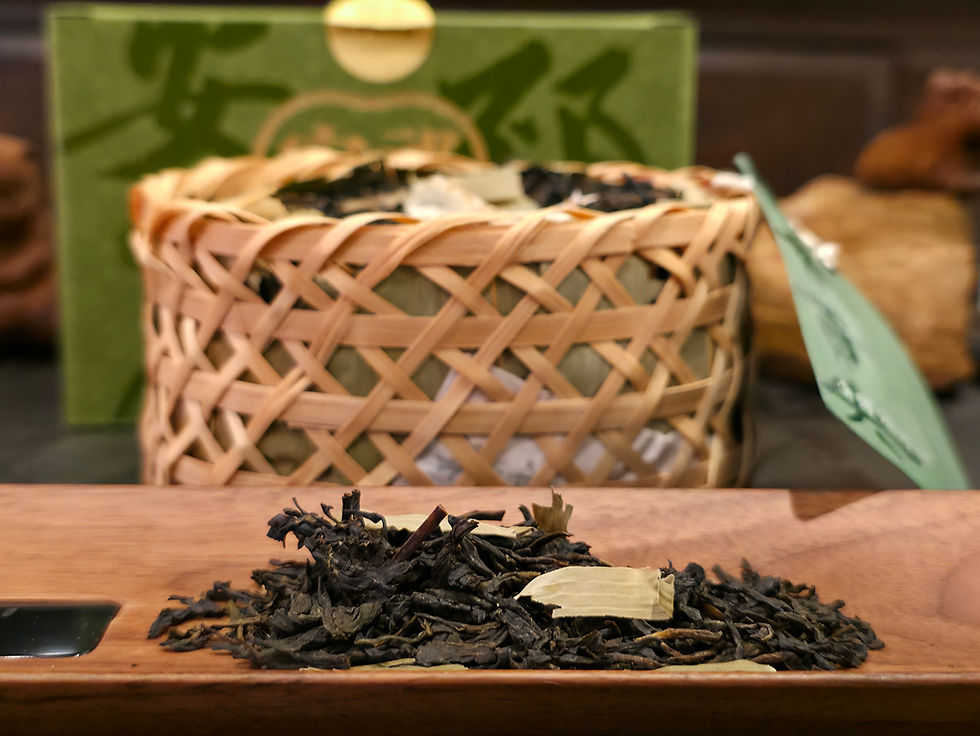The Dangers of Cheap Cakes
- Neldon Hamblin

- Nov 1, 2021
- 4 min read
Updated: Nov 2, 2021
Hello friends! Today's post will be an educational one that many tea-drinkers learn when starting out. If the price of the tea looks too-good-to-be-true, it most definitely is. Pictured above is what appeared to be a harmless cake of ripe (shou) puerh, which I saw at my local international grocery store for $5.00, being sold only as "Yun Nan Puer Tea". I bought it blindly not knowing what type of puerh it was, only being able to smell through the packaging typical woody aromas from shou. At first glance, this might look like a decent cake for the price and can seem extremely appealing to someone just entering the wonderful world of puerh. However, as I dug into this cake, the horrors of cheap, factory cakes began to emerge, many of which I wish I hadn't seen. Don't be fooled by the appearance of huangpian leaves in there- it's likely the manufacturer threw them in as if to say "hey, this cake is entirely twigs- let's give them some leaves too".
Readers, this cake was full of horrors. Like an experience with some eldritch being incomprehensible to the mind, I ran screaming from this cake. I will never be the same. Beware of the $5.00 shou cakes!!!
Bugs, Hairs, and Cotton, oh my!

Let's start with the obvious one here, human hair. Now, to find hair in a tea cake isn't uncommon and happens to all of us. There are a few strands of hair in this piece alone, which is a sign of poor quality control and manufacturing conditions. Finding a single hair isn't too worrisome, but to find several stands of hair in one piece of the cake? This alone is a sign that this cake should not be drank. To avoid disgusting all of you as readers, I didn't capture a picture of this, but there was an entire clump of hair buried in this piece. For visual reference, think of something that would emerge from a shower drain. Yeah, not pleasant and definitely not something you want to drink.

Now, besides hair? There were also "小白茶虫"- or "little white tea worms" crawling on the cake and their darker gray counterparts hidden throughout the cake itself. I found this image on Baidu and it demonstrates what tea worms can look like. This is an image of the actual tea bugs that will be in the tea. Most of the time, you'll instead get "paper bugs"*.
However, in most cases, you'll find something like this:

It's very difficult to see, but in this cake you can see the white specks of paper left from the bug as well as an indication of the presence of insects- an uneven area filled with holes near the central "beenghole".
Now we have more debris, in this case it's cotton or twine of some sorts pressed into the cake. This likely could've come from the cotton bags they use when compressing puerh cakes. In the scheme of things, not too bad, but still prevalent enough to note. This again indicates poor quality control and manufacturing conditions.
Wet leaves, Nei Piao and Nei fei
Now onto the nei fei, wrapper, and nei piao. The neifei is clearly a counterfeit pressed into the cake- I can't find anything out there, so I'm not 100% certain, but this seems like a counterfeit Menghai area nei fei. Even the wrapper tries to fool one into thinking they're getting a $5.00 ripe from Menghai Tea Factory, but after looking closely one can see that even the Dayi logo is incorrect and the ring of characters surrounding the "cha" character are fuzzy and poor copies of the real deal. The nei piao is vague and uses buzzwords like "certified organic", “Product of Ban Zhang Tea District, Yunnan Province, China"**, "ban zhang wang" (which essentially means "King of Ban Zhang"- there's no way in the entire multiverse that this cake of horrors is LaoBanZhang material- which is usually never pressed as a ripe and sure as hell wouldn't be $5.00; if it were real LBZ material, I'd now be extremely wealthy and reselling these cakes haha), and "menghai tea factory in Xishuangbanna". It's entirely possible this is a pre-2006 cake from Menghai Tea Factory (aka Dayi- they introduced anti-counterfeit measures in 2006) but I highly doubt it, given the saturation of the market with fake Menghai teas. The brew is typical for a shou but lacks depth and tastes primarily of wood with no other notes. Definitely not a high quality shou and we can tell this by how choppy and broken the leaves are in the gaiwan.
Conclusion and Tips:
This is a useful experience to have. Try blind-buying cheap cakes and it'll help you identify and learn the traits of fakes and poor-quality teas. My bottom line? If it tastes good, great- who cares if it's fake or not? In this case, and in many others though, the tea will not taste good and could potentially be dangerous to consume. Always buy from trusted vendors when you're wanting something legit, but for a learning experience this is totally acceptable. Who knows, that $5.00 cake might be your daily-drinker- it's cheap and brews like a shou should but without the depth of flavors. Definitely be careful with what you buy and choose to drink.
Ultimately, tea is an agricultural product and there's always a chance of getting contaminants. It's just like with wheat, rice, etc. There's always a warning of some contaminants, be they insects, human-detritus, etc. However, we should know and recognize what is and isn't an acceptable level of contaminants.
So, what are my tips for buying tea cakes?
• Buy from trusted vendors who specialize in puerh and have reputable storage conditions
• If the price looks too good to be true, it is
• If the cake is loosely compressed with lots of twigs showing, it's probably a lower-quality cake with more filler material (note: stems aren't bad! They can add flavors and be quite nice)
• If branding is lacking, generally assume it's a cheap fake
*For those interested in more reading, here's an amazing article in Mandarin about tea bugs: https://crbaicha.com/show.asp?id=121
**Major thanks to Alex of Gold Mountain Teas for his help translating the wrapper!!


























Comments